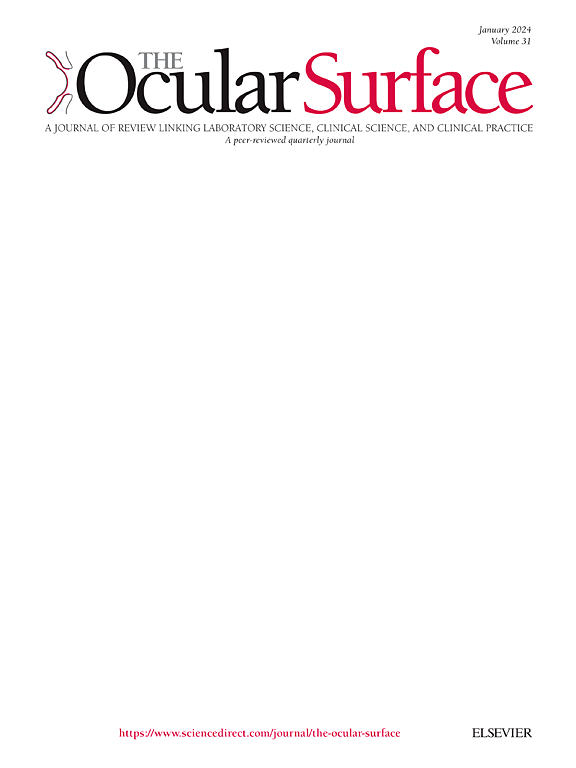通过多组学和MALDI-MSI分析解读真菌性角膜炎中S1P下调和鞘脂稳态破坏。
IF 5.6
1区 医学
Q1 OPHTHALMOLOGY
引用次数: 0
摘要
目的:真菌性角膜炎(FK)缺乏有效的治疗策略,因此迫切需要了解其致病机制以提高治疗效果。鞘脂已被证明在真菌感染的发病机制中起关键作用,但鞘脂的具体改变和调控途径仍是未知的。我们的目的是通过多组学分析来深入了解FK中鞘脂稳态的病理生理机制。方法:采用基质辅助激光解吸/电离-质谱成像(MALDI-MSI)对FK患者和小鼠模型进行研究。此外,采用时程RNA-seq和加权基因共表达网络分析(WGCNA)来揭示FK的驱动基因。我们进一步研究了1-磷酸鞘氨醇(S1P)模拟物FTY-720对FK进展的影响。结果:FK患者MALDI-MSI分析显示鞘脂下调,其中鞘脂代谢是最显著的富集途径。这些变化在小鼠模型中得到验证,在小鼠模型中发现S1P、神经酰胺、神经酰胺1-磷酸和鞘磷脂下调。时间过程转录组学分析表明,特定酶降解鞘脂驱动FK的进展,包括磷脂降解、TOR通路下调和先天免疫反应的激活。因此,上皮细胞功能受到抑制,细胞死亡增加。重要的是,通过FTY-720恢复鞘脂稳态可以逆转S1P水平,缓解FK的进展。结论:总之,本研究揭示鞘脂稳态的破坏促进了FK的疾病进展。此外,恢复鞘脂稳态是缓解FK进展的一种有希望的策略。本文章由计算机程序翻译,如有差异,请以英文原文为准。

Deciphering S1P downregulation and sphingolipid homeostasis disruption in fungal keratitis via multi-omics and MALDI-MSI analysis
Purpose
The absence of effective treatment strategies in Fungal Keratitis (FK) emphasizes the critical need to understand the pathogenic mechanisms to enhance therapeutic outcomes. Sphingolipids have been proved to play a pivotal role in the pathogenesis of fungal infections, but the specific alteration in sphingolipids and regulatory pathways remain elusive. Our aim is to gain insight into the pathophysiological mechanisms of sphingolipid homeostasis in FK through multi-omics analysis.
Methods
Matrix-assisted laser desorption/ionization-mass spectrometry imaging (MALDI-MSI) was performed in FK patients and mouse model. Furthermore, time-course RNA-seq was performed and Weighted gene co-expression network analysis (WGCNA) was used to reveal the driver genes in FK. We further investigated the effect of FTY-720, a mimetic of sphingosine 1-phosphate (S1P), on the progression of FK.
Results
MALDI-MSI analysis of FK patients revealed a downregulation of sphingolipids, with sphingolipid metabolism identified as the most prominently enriched pathway. These alterations were validated in mouse model, in which S1P, ceramide, ceramide 1-phosphate and sphingomyelin were found to be downregulated. Time-course transcriptomic analysis suggests that degradation of sphingolipids by specific enzymes drives the progression of FK, involving phospholipid degradation, downregulation of TOR pathway, and activation of innate immune response. Consequently, epithelial cell function was inhibited and cell death increased. Importantly, restoring sphingolipid homeostasis by FTY-720 reversed the level of S1P and relieved the progression of FK.
Conclusion
In summary, this study reveals that disruption of sphingolipid homeostasis promotes disease progression in FK. Furthermore, restoring sphingolipid homeostasis emerges as a promising strategy to mitigate the progression of FK.
求助全文
通过发布文献求助,成功后即可免费获取论文全文。
去求助
来源期刊

Ocular Surface
医学-眼科学
CiteScore
11.60
自引率
14.10%
发文量
97
审稿时长
39 days
期刊介绍:
The Ocular Surface, a quarterly, a peer-reviewed journal, is an authoritative resource that integrates and interprets major findings in diverse fields related to the ocular surface, including ophthalmology, optometry, genetics, molecular biology, pharmacology, immunology, infectious disease, and epidemiology. Its critical review articles cover the most current knowledge on medical and surgical management of ocular surface pathology, new understandings of ocular surface physiology, the meaning of recent discoveries on how the ocular surface responds to injury and disease, and updates on drug and device development. The journal also publishes select original research reports and articles describing cutting-edge techniques and technology in the field.
Benefits to authors
We also provide many author benefits, such as free PDFs, a liberal copyright policy, special discounts on Elsevier publications and much more. Please click here for more information on our author services.
Please see our Guide for Authors for information on article submission. If you require any further information or help, please visit our Support Center
 求助内容:
求助内容: 应助结果提醒方式:
应助结果提醒方式:


